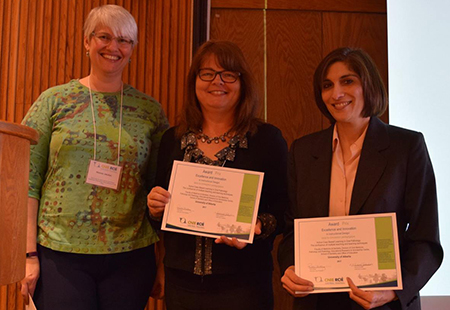
Canadian Network for Innovation in Education (CNIE) President Melissa Jakubec presents Kari Rassmusen from the School of Dentistry's Educational Research Scholarship Centre and oral pathology professor Seema Ganatra with the CNIE award in Instructional Design.
Congratulations to Drs. Seema Ganatra, Tania Doblanko, John Valentine, Kari Rassmusen, and academic technology specialist Patrick von Hauff on receiving the Canadian Network for Innovation in Education (CNIE) award in Instructional Design.
Their student-centred seminar titled, Active Case Based Learning in Oral Pathology: The confluence of multiple teaching and learning techniques was recognized for positively impacting student learning, May 17.
Ganatra and her team held 8 oral pathology- focused seminars, which third and fourth-year dentistry students attended. During these seminars, students were expected to use their knowledge to diagnose real-life oral pathology cases based on actual patients. The cases selected were those students may not be exposed to during their clinical education, but were likely to see in private practice.
The team worked to design a "think-pair-share" activity, where students solved the cases individually, then compared answers in mixed pairs of third and fourth year students, and finally shared the cases with everyone present at the seminar.
"We were really pleased to receive this award," says Ganatra. "I found an excellent team to work with and it was a great educational achievement. It was active learning for our students and they really responded positively to it."
Doblanko, who is a dentistry graduate and former general practice resident from the School of Dentistry, had the opportunity to participate in these seminars to provide feedback on the cases based on her own experience in recent practice.
"Recognition like this reminds us that innovation in teaching is important. Enhancing seminar experiences for dentistry students is noteworthy, and a path we should continue on," says Doblanko. "Many similar cases are discussed in lectures, but here the onus is on the students to apply this knowledge to diagnose and determine how they would manage a patient without having answers given by the instructor.
"At the end, students can compare their thought process with the oral pathologist and other instructors present. Ultimately, this facilitates discussion in a way that is tailored to the students."